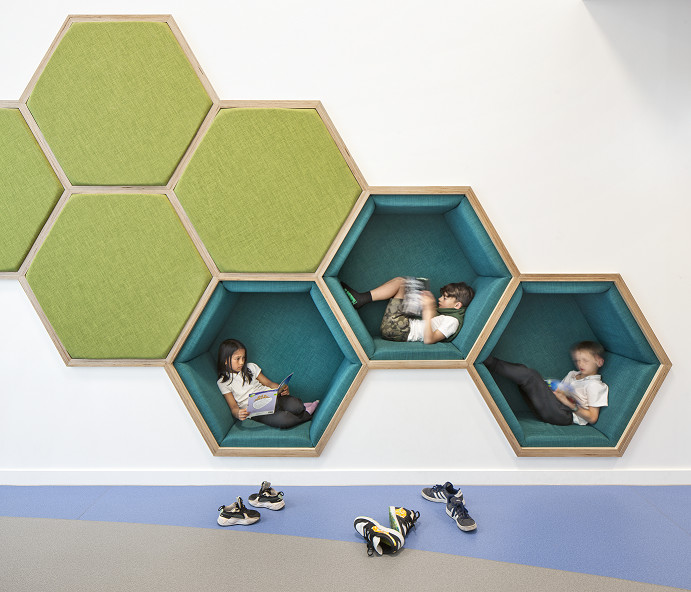Re-thinking energy in education

When considering energy in education, most people immediately associate it with ‘cost’: the optimisation of energy efficiency to save money. Graeme Shaw, Technical Director at Zumtobel Group, UK and Ireland, discusses his campaign for an imperative shift in this focus – from a cost driven approach where educational facilities ‘light by numbers’ to meet a standard or conserve energy to places with student wellbeing at their core.
Lighting design and maximising daylight play pivotal roles in educational spaces. By establishing connections to nature within buildings, they boost creativity and enhance mental clarity.
However, there is a concerning reality: British primary school children spend over 7,000 hours at school by the end of their 6th grade, with a substantial proportion of this time confined within a single classroom designed before the development of dynamic lighting and digital technologies like smart boards and tablets.
Alarmingly, children are also spending an increasing amount of time glued to screens at home. Typically, children with access to the internet will spend two hours and 45 minutes online daily up to the age of eight, rising to over four hours by the age of 11 to 12. This is despite mounting evidence supporting the critical role of ‘green time’ (time in nature) in children’s psychological wellbeing and academic achievement. An inadequacy that necessitates an understanding of the potential side effects on students’ health and academic performance.
Except for a limited number of new, state-of-the-art facilities, the prevailing condition of learning environments in the UK exposes a stark reality: our schools are suffering from chronic underfunding and, frankly, inadequate lighting. This extends beyond infrastructural issues; poorly lit classrooms can significantly contribute to visual stress, undermining overall wellbeing, a concerning fact that demands immediate attention and decisive action.
While we focus on costs, there is compelling research that indicates that ‘healthy lighting’, lighting with a modified light spectrum invisible to the eye, but that has the same beneficial effects on humans as daylight (pupils less stressed, eyes more relaxed, lighting where the biological rhythm is positively influenced), has a profound impact on productivity and learning outcomes.
Lighting for learning and resource saving – what we know
Children’s eyes differ from adults’ in their light sensitivity – their eyes are more permeable to light, especially ultraviolet and blue light. Their smaller pupils and reduced melatonin suppression compared to adults make them more vulnerable to glare. This heightened sensitivity impacts their sleep-wake cycles and circadian rhythm, which govern our 24-hour internal clock.
We know that cases of myopia (short-sightedness) have more than doubled in the past 50 years and now affect one in six children in the UK by the time they are 15. More research is needed on why we’ve seen such a significant increase. However, it is believed to be primarily linked to the environment: children spend more time indoors, on screens, reading, and not getting enough daylight. Studies conclude that exposure to blue-rich light, especially during morning sessions, increases academic performance, concentration, and progression of students, while warm lighting can
affect social behaviour.
Higher red-spectrum proportion and dimmed room lighting create a calm and private space. This ambience also supports reading aloud sessions, prayers, mindfulness breaks and communication. Violet to azure (similar to natural sunlight), reduces eye strain, is supportive of circadian entrainment and increases the melanopic content of the light.
Classrooms are currently designed to provide a uniform distribution of light. In the absence of natural light or insufficient natural light, a minimum illuminance of 500 lux (300 lux may be used by dimming if used by young children) 0.6 uniformity,
UGR19 and Ra 80 is widely regarded as suitable for general tasks – designed to fulfil the requirements of BS EN12464-1.
Lighting beyond standards
Moving beyond meeting basic lighting standards, we’d like to see the creation of adaptive learning spaces that cater to the dynamic needs of modern education. Right luminaire, right place, controlled in the right way. It is important to invest in lighting not just as a functional necessity but as a supplementary tool that enhances the learning experience.
Whether we’re aware of it or not, people have a psychological and physiological need to connect with nature. In its absence, and windows are not always enough, we need to re-think the value of artificial lighting.
Looking ahead
This year, I’d like to see more schools shift towards more human-centric lighting solutions. Innovations such as Zumtobel’s Spectrum, which we developed in
collaboration with Nichia, replicate daylight’s benefits with reduced blue wavelengths and enhanced azure wavelengths, imperceptible to the human eye, but that significantly improve students’ concentration quality, efficiency, and lower fatigue. This transformative lighting approach eases retinal strain, ensuring relaxed visual experiences akin to daylight conditions. It fosters sustained comfort, aids concentration and speeds up recovery after taxing visual tasks.
While lighting does account for a large proportion of energy costs schools, good design, specification, management and controls can have a significant impact on
limiting electricity consumption, saving energy, keeping running costs to a minimum, while providing the nurturing environment our children need with solutions that also benefit health and wellbeing.
Embracing lighting solutions that prioritise wellbeing will redefine educational facilities’ interaction with light, brightening spaces and enhancing and creating healthier and more productive environments for students and teachers alike.
Recommendations for future schools
In conclusion, with the pressure to meet energy targets, have we forgotten what a privilege – and a responsibility it is – to shape the environment for our future generations? Educational lighting needs to do more than just meet lighting standards within a room. We must light in alignment with users’ needs. To create atmosphere. To support visual tasks. To create classrooms that are fit for the 21st century.







